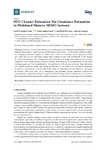FDD Channel Estimation Via Covariance Estimation in Wideband Massive MIMO Systems

Use this link to cite
http://hdl.handle.net/2183/25174Collections
- Investigación (FIC) [1678]
Metadata
Show full item recordTitle
FDD Channel Estimation Via Covariance Estimation in Wideband Massive MIMO SystemsDate
2020-02-10Citation
González-Coma, J.P.; Suárez-Casal, P.; Castro, P.M.; Castedo, L. FDD Channel Estimation Via Covariance Estimation in Wideband Massive MIMO Systems. Sensors 2020, 20, 930.
Abstract
[Abstract] A method for channel estimation in wideband massive Multiple-Input Multiple-Output systems using hybrid digital analog architectures is developed. The proposed method is useful for Frequency-Division Duplex at either sub-6 GHz or millimeter wave frequency bands and takes into account the beam squint effect caused by the large bandwidth of the signals. To circumvent the estimation of large channel vectors, the posed algorithm relies on the slow time variation of the channel spatial covariance matrix, thus allowing for the utilization of very short training sequences. This is possibledue to the exploitation of the channel structure. After identifying the channel covariance matrix, the channel is estimated on the basis of the recovered information. To that end, we propose a novel method that relies on estimating the tap delays and the gains as sociated with each path. As a consequence, the proposed channel estimator achieves low computational complexity and significantly reduces the training overhead. Moreover, our numerical simulations show better performance results compared to the minimum mean-squared error solution. View Full-Text
Keywords
MmWave
Massive MIMO
Hybrid architectures
FDD
Channel estimation
Beam squint
Massive MIMO
Hybrid architectures
FDD
Channel estimation
Beam squint
Editor version
Rights
Atribución 3.0 España
ISSN
1424-8220






